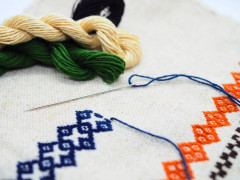こぎん刺しとは?(What is Kogin?)

こぎん刺し(こぎんさし)とは
日本の青森県津軽に伝わる刺し子の技法のひとつである。
江戸時代寒冷な津軽地方では木綿の栽培ができず、綿製品は高価だった。 「農家倹約分限令」により、農民は仕事着、普段着において木綿の使用が禁止され、紺麻布を着衣として用いていた。 しかし麻布は通気性が良すぎるため、津軽地方の冬の寒さを防ぐことができなかった。 農家の女性は麻布に綿糸で刺繍をして布地の目を埋める事で保温性を向上させ、刺繍を細かくすることで、補強や装飾にもつながった。
“Kogin” is the one of the techniques for needlework which has been handed down for generations in the Tsugaru area, Aomori pref in Japan.
In Ed era (from the beginning of 17th century to mid of 19th century), Tsugaru area was so cold that people could not make cotton grow, and the cotton goods were so much expensive. Because the government ordered farmers not to spend their money for expensive items, they were prohibited from using cotton for the clothing in their daily works and lives. Therefore, people usually had to wear linen clothing dyed with dark blue. However, linen was so thin that it could not keep the farmers’ bodies warm against the cold air, especially in the severe winter of Tsugaru area. Females in the farmers handcrafted to cover the holes of linen, supplemented with the cotton thread, and by doing so, they improved the quality of warmth of linen clothing. Moreover, detailed needlework made the linen clothing improve the strength and decorations.

